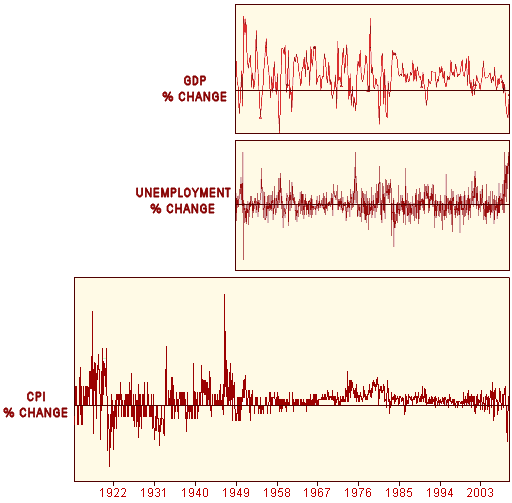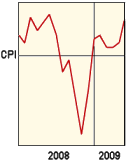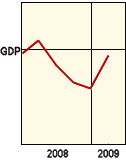
| I haven’t been consistent in the way I’ve displayed these figures. So I asked myself, "What would Nate do?" [Nate Silver of FiveThirtyEight]. Since the Gross Domestic Product and the Consumer Price Index are always on the rise, people use the "percent change since the last period" as a way of leveling out the figures to look at the change of the moment. In my previous [monotonous] graphs, I’ve varied between the raw figures and this % change number. Here, all three are shown as % change [Gross Domestic Product, Unemployment, and Consumer Price Index], going back as far as the data is available on the government sites. I think that’s what Nate would do. |
The thing I’ve been trying to get my mind around is something like "How big was this crash?" and "Was there really a danger of another Great Depression?" Since our economy is cyclic [going through business cycles], how can we be sure that this wasn’t just a "garden variety" Recession instead of something that was spinning out of control [like the 1929 Crash that was followed by the Great Depression]?


That’s not the whole story. My guess is that the dramatic burst in the Market during the period from 1980 to 2008 also reflects the massive Deregulation of our economic marketplace, so it’s almost impossible to partition all these factors for a mortal like me – the deficit spending, the deregulation, the economic bubbles, the hedge funds, the derivative markets, and who-knows-what else. But back to the original point, one thing suggesting that this was a dangerous crash was the magnitude of the fall of the Real DOW [50%] in a very short time.
 The CPI is the marker for inflation. It’s the cost of a fixed package of goods, and it rises over time. Rampant INFLATION [see the late 1940’s above] means that money is losing its value rapidly. Things are stable when it’s a slow steady upward climb. Notice the Inflation/Deflation period after World War I. But the big story is the 1929 Crash and its aftermath – known as a DEFLATIONARY SPIRAL. The CPI plummeted and stayed down, an index of the panic that characterized the Hoover years. Hoover was unwilling for the government to intervene, and the pain just kept coming. FDR’s massive intervention with the New Deal reversed the fall, but it recurred when he backed off in 1937 – a lesson repeatedly highlighted by our modern economists: Don’t back off too soon!
The CPI is the marker for inflation. It’s the cost of a fixed package of goods, and it rises over time. Rampant INFLATION [see the late 1940’s above] means that money is losing its value rapidly. Things are stable when it’s a slow steady upward climb. Notice the Inflation/Deflation period after World War I. But the big story is the 1929 Crash and its aftermath – known as a DEFLATIONARY SPIRAL. The CPI plummeted and stayed down, an index of the panic that characterized the Hoover years. Hoover was unwilling for the government to intervene, and the pain just kept coming. FDR’s massive intervention with the New Deal reversed the fall, but it recurred when he backed off in 1937 – a lesson repeatedly highlighted by our modern economists: Don’t back off too soon!The significance of the CPI in this Recession can’t be over-emphasized. Looking at the longitudinal data above, this parameter hasn’t fallen like this since the Great Depression. In fact, the fall last year was even more abrupt than in 1929. As much as I wouldn’t like to give Bush credit for anything, the massive intervention after Lehman Brothers failed seems to have stemmed the tide, though the election of a Democrat as President at the same time may have been a factor. The fall of the CPI is the biggest evidence that this Recession was not going to be self-limiting.
 The changes in the GDP and UNEMPLOYMENT are typical of Recession, though the numbers are ominous in a qualitative sense. There is no Recession since WWII with a rise in UNEMPLOYMENT like this one and the GROSS DOMESTIC PRODUCT fell at an alarming rate and stayed low for several quarters.
The changes in the GDP and UNEMPLOYMENT are typical of Recession, though the numbers are ominous in a qualitative sense. There is no Recession since WWII with a rise in UNEMPLOYMENT like this one and the GROSS DOMESTIC PRODUCT fell at an alarming rate and stayed low for several quarters.  Some have called this THE GREAT RECESSION, and that seems an apt term, given that things continue to improve. There are three things that have worried me during this particular economic cycle. First, there is no safe buffer. Reagan/Bush/Bush have run up the National Debt so there’s little room to borrow heavily to combat economic downturns. Secondly, the Deregulation of our Markets leaves us wide open for further Bubbles and other Market manipulations like the Derivative debacle. Finally, the Republican Party which has been the champion of Capitalism seems to have lost its mind and is now championing a kind of Free-Market Capitalism that almost got us this time, and could literally take us out next time.
Some have called this THE GREAT RECESSION, and that seems an apt term, given that things continue to improve. There are three things that have worried me during this particular economic cycle. First, there is no safe buffer. Reagan/Bush/Bush have run up the National Debt so there’s little room to borrow heavily to combat economic downturns. Secondly, the Deregulation of our Markets leaves us wide open for further Bubbles and other Market manipulations like the Derivative debacle. Finally, the Republican Party which has been the champion of Capitalism seems to have lost its mind and is now championing a kind of Free-Market Capitalism that almost got us this time, and could literally take us out next time.
Sorry, the comment form is closed at this time.